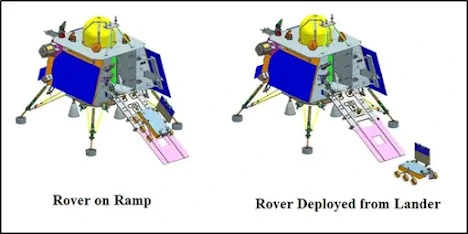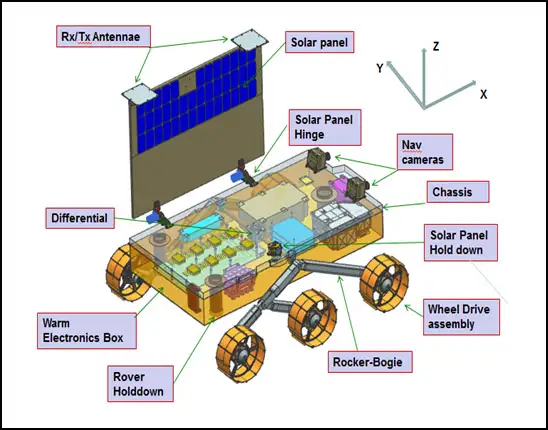India’s Chandrayaan-3 mission is a follow-up to the Chandrayaan-1 and Chandrayaan-2 missions. The mission aims to soft-land a rover on the Moon’s South Pole. The rover will be equipped with a variety of instruments to study the lunar surface and atmosphere.
ISRO'S CHANDRAYAAN-3 MISSION - India's Third Lunar Mission
After the unfortunate Chandrayaan-2 mission, ISRO is now ready to go off for another mission to the moon. India’s first mission to the moon was in 2008 called ‘Chandrayaan-1’.
Among the countries including the Soviet Union, the United States, Japan, the European Space Agency, China, Luxembourg, Israel, Italy, South Korea, and the United Arab Emirates, INDIA is also one of them competing in the race.
Chandrayaan 2 was launched on 22 July 2019. After that, this is the year.

Chandrayaan-3 is a follow-on mission to Chandrayaan-2 to perform end-to-end capability in safe landing and roving on the lunar surface.
It consists of Lander and Rover. It will be launched by LVM3 from SDSC SHAR, Sriharikota.

The propulsion module will carry the lander and rover configuration till the 100 km lunar orbit. The propulsion module also has a ‘Spectro-polarimetry of Habitable Planet Earth (SHAPE)’ payload that will study the spectral and Polari metric measurements that will hence study Earth from the lunar orbit.
Let’s understand why are we exactly doing this mission:
Objectives:
To perform a Safe and Soft Landing on Lunar Surface ( Land a rover on the Moon's South Pole )
To demonstrate Rover roving on the moon
Study the Moon's geology and composition.
Search for signs of water on the Moon.
Demonstrate new technologies for future lunar missions.
India wants to look at the Moon’s surface, particularly in regions that haven’t seen sunlight in a few billion years. These darker regions of the moon's surface may contain ice and actual rich mineral deposits, according to many scientists and astronomers.

Chandrayaan-3 Rover ( Image by ISRO )
According to ISRO, the Chandrayaan-3 mission will cost more than Rs 600 crores in total. In contrast, the Chandrayaan-2 mission cost a total of Rs 960 crores.

But still less and more efficient than any other country.
What happened to Chandrayaan 2?
• The Chandrayaan-2 mission, which was aborted in 2019 after making a rough landing on the Moon’s dark side, is still operational thanks to its orbiter that is still in place.
• In the last seconds when the lander was about to land, it crashed and was completely destroyed.
• Chandrayaan 2’s main goal was to show off its capacity to soft-land on the moon’s surface and control a robotic rover there.
• But in the past two years, the Chandrayaan-2 mission’s Orbiter and other instruments have gathered a lot of new data that has widened our understanding of the Moon and its surroundings. This is super cool, isn’t it?
What information did ISRO get back?
• We got the most accurate data that H20 water molecules are present on the moon.
• We have found that the elements chromium, manganese, and sodium have all been discovered for the first time. The discovery may open up new opportunities for us to research planetary exploration, nebular conditions, and lunar evolution.
• Understanding the solar flares outside the earth’s atmosphere.
Studying the darker unexplored part of the moon and its various craters might give us information and history about the moon.
Why are we interested in studying the moon?
• The Moon is the closest celestial body at which space discovery can be attempted and documented.
• It can also be used as a test bed to demonstrate technologies required for deep-space missions just like a food court stop on a long highway. Just to refuel your spacecraft.
• Moon also has an important link to Earth’s early history.
• It could also open the doors to understanding the evolution of the whole solar system
Why is the moon's south pole the landing location?
• The shadow-covered portion of the lunar surface at the South Pole is way bigger than the North Pole, which makes it interesting.
• There might be a chance that regions near it that are always in darkness contain water.
• A fossil record of the early Solar System can also be found in cold trapped areas and craters near the South Pole.
• The craters found at the southern pole are of great interest to scientists. They think the mysterious fossil records of the early planetary system may be present in these cold traps.
Some details about the Chandrayaan-3 mission:
Launch date:
The wait is over, it’s finally launching on the 12th of July if all the weather conditions work for the day.
Let’s keep our fingers crossed and hope for all the best results to come out by the end of the mission.
Launch site:
Satish Dhawan Space Centre, Sriharikota, Andhra Pradesh, India
Rocket:
Geosynchronous Satellite Launch Vehicle-Mk III (GSLV-Mk III)
Orbiter:
Chandrayaan-3 Orbiter
Lander:
Vikram lander
Rover:
Pragyan rover
Payload:
The Chandrayaan-3 mission will carry a variety of payloads, including:
- A rover will be equipped with a drill to collect samples of the lunar surface.
- An orbiter that will map the Moon’s surface and atmosphere.
- A lander that will provide support for the rover and orbiter.
Timeline:
The Chandrayaan-3 mission is scheduled to launch in July 2023. The rover is expected to land on the Moon’s South Pole in September 2023.
The Chandrayaan-3 mission is expected to last for one year. The orbiter will orbit the Moon for one year, while the lander and rover will attempt to soft-land on the Moon’s South Pole. The rover will then explore the lunar surface for up to 14 days.

Chandrayaan-3 – Mission Profile ( Image by ISRO )
The Chandrayaan-3 mission is a significant step forward for India’s space program. It is the first time that India will attempt to soft-land a rover on the Moon. The success of the mission will help India to become a leading spacefaring nation.
Author – Gauri Rahul Kshirsagar